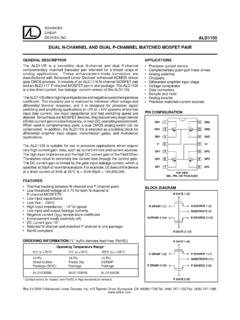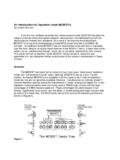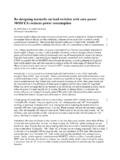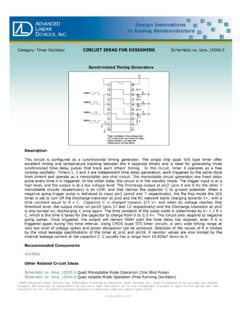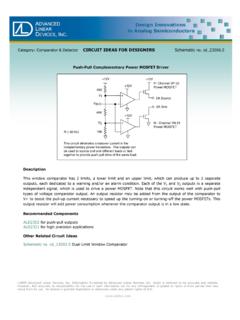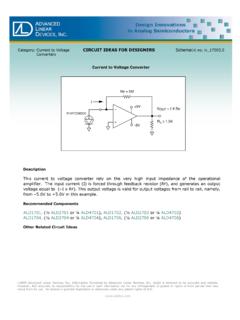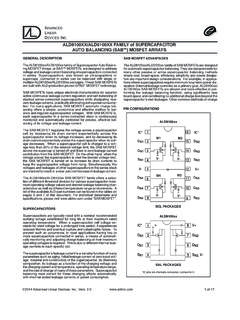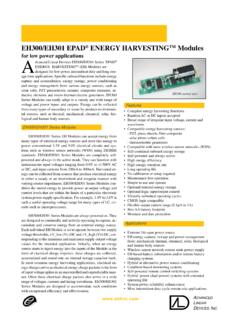Transcription of Sub-threshold MOSFET Behavior for Analog …
1 Sub-threshold MOSFET Behavior for Analog applications Current leakages are ever present in electronic systems, and many forms of leakage are considered by engineers to be unusable. This thinking is starting to change as new frontiers in ultra-low power begin to be exploited through precise control of Sub-threshold leakage currents of MOSFET devices for Analog applications . Fortunately for the Analog engineer, the Sub-threshold voltage characteristics of MOSFET . devices allow this voltage to be harnessed and used in the nanopower region, opening up a wide array of possibilities for useful and repeatable circuits. Sub-threshold voltage is still very difficult to control but as the era of nanopower dawns and starts to expand, once 'unusable leakage current previously thought to be a waste may now be spun into gold, said John Skurla, Director of Marketing at Advanced Linear Devices, Inc.
2 Energy harvesting, for example, is a rapidly expanding field of research and development. Efforts are now just beginning to unlock the possible applications of a field that benefits from nanopower operations. But the potential for this field has yet to be tapped because of the limitations involved with harnessing, storing and distributing micro power energy. The ability to store energy with minimal leakage is a key factor to the continued advancement of applications in this field. It's a commonly accepted practice to consider a device to be switched off when current drops below the gate threshold voltage. A threshold voltage of 1 Volt can be used as an example. Any current below 1V would be considered useable and therefore wasted. Historically, control of this leakage current below the threshold voltage, or sub threshold leakage current within a certain range has turned out to be quite difficult.
3 To understand the limitations holding back the development of nanopower, consider a MOSFET device, or any similar device where the gate voltage falls below the gate threshold voltage. Any remaining voltage below gate threshold voltage is considered to be the device's Sub-threshold region, however current drops off exponentially when there is even a relatively minimal drop from Volt to Volt. Designers usually refer to this drop as 100 millivolts per decade of current, so for every drop in voltage, current drops by ten times or by an order of magnitude. Sub-threshold current as a function of Sub-threshold voltage can be approximately 110mV/decade of current from 1 A to 10pA. As an example, for a threshold voltage( VGS (th)) of , when gate-to-source voltage, VGS, is equal to , the drain current (ID) is 1 A; When gate-to-source voltage ,VGS, is equal to , the drain current has decreased from one microamp to 150 nano Amp; When gate-to-source voltage is further reduced by another 100.
4 MV, to , the drain current continues to decrease by about another order of magnitude, to 20nA. For the device described above, when gate-to-source voltage is tied to ground potential, or , the drain current is now about For many applications , ground potential is not only a convenient reference voltage, but also an accurate one as depicted in the Figure 1 below. Therefore, a MOSFET device with a gate threshold voltage of exactly will have a drain-to- source current of nA when its gate is grounded. FIGURE 1. Figure 1: Sub-threshold characteristics for a device with 110mV per decade of current is a typical example. Consider that when gate voltage dips to volt, current has been reduced by approximately 30,000 times below threshold and it's very easy to imagine why it would be considered off.
5 This reduced current, however, operates on a well-behaved curve. When a switch is turned off, there is power behind the gate of the circuit below threshold, so off is not completely off in many cases. This same concept enables cell-phones to operate in sleep mode, for example, conserving battery life when not in use and then waking up when a call or text message is received. In a similar fashion many security systems, such as a battery-powered alarm backup, have to operate in deep sleep mode perhaps as long as five or ten years, and then wake up to complete its function when it senses a specified event or Behavior . The ability to operate this type of circuit in nanopower that is in the Sub-threshold region can greatly extend battery life by preserving battery power in sleep mode, thus enhancing security abilities.
6 Further, working in the Sub-threshold region is imperative for unlocking the benefits of nanopower and for driving innovation in energy harvesting and many other fields. Using Sub-threshold in Analog Design When the Sub-threshold current is unwanted in a design, it is regarded as parasitic leakage current, which only dissipates power for the circuit without serving any useful purpose. This parasitic leakage is added to and grouped with other types of leakage currents, such as junction leakage, gate oxide leakage, package-level surface leakage and printed circuit board leakage currents. Most of these aforementioned types of leakage currents, however, are the product of contamination and imperfection in manufacturing and fabrication. All these leakage currents are generally targeted to be minimized and eliminated as much as possible with only a maximum specification value, but usually with no minimum value.
7 In other words, a leakage current of exactly zero value would be considered ideal. Sub-threshold leakage currents are different from these other types of leakage currents. A zero value for this Sub-threshold leakage current is not acceptable, as the resistor value becomes infinitely large when the current denominator is zero. Engineers therefore sought to minimize it and treat it as a junky current that only adds to the power budget without any useful benefit. When the gate-to-source voltage and the threshold voltage are controlled, then the leakage current can be controlled and reproduced. When controlled within a certain maximum and minimum range, then it becomes a resistive element that an engineer can use. This becomes important when the value of the resistive element is very large, exceeding most commonly available resistors.
8 For nanopower applications , very large-valued resistors are common in order to limit circuit power dissipation. One major advantage of operation in the Sub-threshold mode is the ability to generate very low levels of current between the source and drain, thereby creating a very high-valued resistor, in the order of hundreds of MEG Ohms to GigaOhms range. For example, to build a 500 MegaOhm resistor would require 23 units of 22-MegOhm resistors strung together. This high-valued resistor can bias a MOSFET device to generate very low-level current sources, however the resistor value is fixed at only one precise input gate voltage, and is only valid for a specific threshold voltage. The same high gm of the weak inversion mode also produces a resistor but with very high variation in its resistor value as a function of the applied gate voltage and the threshold voltage itself.
9 Both of these voltages affect a resistor value significantly, and as a result a resistor is produced that generally varies in value too greatly for that resistor to be a usable as a circuit element. An infinitely large resistor value is simply an open circuit which would not lend itself to being useful as an Analog circuit element. As a resistor element, therefore, there needs to be a maximum and a minimum value in order for the resistor to have any meaningful circuit function. The extremely low threshold voltages and precise tolerance range of mosfets are made possible through technology, which allows devices to be electrically trimmed at the factory for these precision specifications. These devices will play an important role in many specific Analog circuits such as current sources, current mirrors, discrete differential amplifiers, Analog multiplexers, and many others.
10 With such precise design techniques, mosfets can be made with gate threshold voltage of + V +/- @ 1 uA, + +/- @ 1 uA or even + +/- The threshold voltage and its relative Sub-threshold voltage of a MOSFET can be used as a voltage comparator and a voltage reference. Historically, you would have both a voltage reference and a voltage comparator. Analog engineers seeking an advantage for operating below gate threshold will soon discover that nanopower is not a cure-all because there is less current to work with and it requires acute sensitivity to make these circuits possible. It takes a new perception to capture all of the possibilities of working in the Sub-threshold region. As an example, a threshold voltage may vary between or If an engineer sees a drop in input voltage, current will have dropped by 1,000 times.
